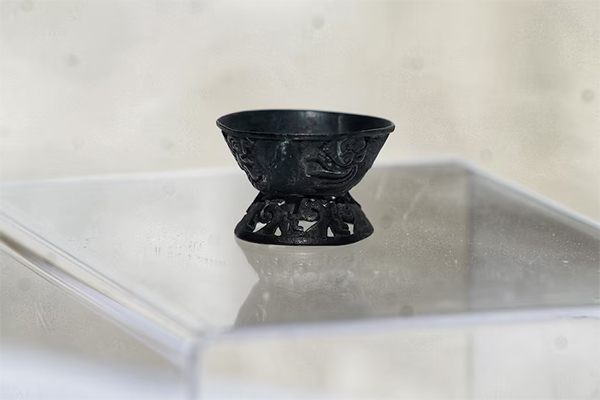In 1923 a Mexican worker painted his experience of surviving being trapped in a mine.(ABC News: Adam Kennedy).
Tahlia Roy, Culturally significant Mexican artefacts seized in Australia handed back to Mexico, ABC News, 27 February 2023
Two culturally significant artefacts have been returned to the Mexican government after they were recovered by Australian authorities.
Key points:
- A 100-year-old painting and copper bowl, estimated to be 800 years old, were seized upon entry to Australia
- The Mexican Ambassador to Australia said Mexico, like Australia, had artefacts stolen from the countries due to colonialism
- According to UNESCO, the theft of indigenous artefacts is most common when a country is experiencing conflict
The Australian government handed back a 100-year-old painting and a miniature copper bowl on Monday, estimated to be up to 800 years old.
The objects were bought by private collectors in Australia from a company in the United States.
But the items were seized by the Australian Border Force, the Australian Federal Police and the Department of Foreign Affairs and Trade when they arrived in Australia and questions were raised about their origins.
Mexican Ambassador to Australia Eduardo Peña Haller was given the artefacts at a ceremony at the Mexican Embassy in Canberra on Monday, and said the “illicit trafficking of cultural arts” was something that could “destroy culture”.
“These objects are not merely things.They are an important part of our culture and history,” Ambassador Haller said.
“And, above all else, they tell particular stories about Mexico’s peoples and our livelihoods.
“Protecting our heritage is like embracing the essence of our culture, feeling the beat of our traditions and listening to the whispers of our ancestors.”

The painting, dated back to 1923, was crafted on tin by a Mexican worker who sought to capture the ordeal of being “trapped for 52 days” while relying on his faith for survival.
Meanwhile, the tiny bowl was created almost 800 years ago by indigenous Mixtecs in southern Mexico, where working with valuable metals was a revered skill.
Ambassador Haller said being able to preserve the pieces was “like a love letter to the past, a message of hope to the present, and a promise for the future”.

He lamented similarities between Australia and Mexico’s history, leading to the theft of many culturally significant artefacts as a result of both countries being colonised.
“In the case of Mexico, Spain conquered Mexico, and in the case of Australia, the English did the same — and I think that has contributed towards the fracturing of our indigenous cultures.”
“Now, both societies are recognising that all those pieces of art are valuable for the young people of Mexico and Australia so that they know about their ancestors.
“I want to thank the Australian government, with whom we closely collaborated, for the safe return of these objects to our country where they can be protected for generations.”
‘Heritage is our legacy from the past, what we live with today, and what we pass on to future generations’
Arts Minister Tony Burke acknowledged the links between the experiences of indigenous Mexicans and Australians, and the commonplace theft of art that had left First Nations people bereaved.
“We are both from nations where many objects have been stolen and are still housed around the world,” Mr Burke said.
“Sometimes, in places that are working cooperatively towards repatriations and sometimes in places with people who obstinately believe they have a right to continue the theft.
“What we’re saying today goes beyond our friendship with Mexico, what we’re saying today goes to the nature of how we should deal with objects that are stolen.
“We will never see every object that should be returned to countries around the world returned, but hopefully today, we help right a wrong.”
The United Nations Educational, Scientific and Cultural Organisation (UNESCO) has promoted international conventions to stop the illicit importing and exporting of cultural property for decades.
In a statement, the organisation said the theft of indigenous artefacts was most common when a country is experiencing conflict.
“Heritage is our legacy from the past, what we live with today, and what we pass on to future generations,” UNESCO said.
“Our cultural and natural heritage are both irreplaceable sources of life and inspiration.”

